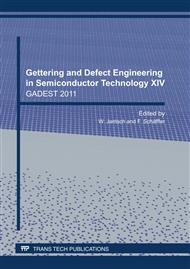[1]
R.C. Newman, Defects in Silicon, Rep. Prog. Phys. 45 (1982) 1163-1210.
Google Scholar
[2]
C.A. Londos, M.S. Potsidi and V.V. Emtsev, Effect of carbon on oxygen precipitation in Czochralski silicon. Physica Status Solidi C 2 (2005) 1963-(1967).
DOI: 10.1002/pssc.200460537
Google Scholar
[3]
Q. Sun, KH Yao, J Lagowski, Effect of carbon on oxygen precipitation in silicon. Journal of Applied Physics 67 (1990) 4313-4319.
DOI: 10.1063/1.344947
Google Scholar
[4]
F. Shimura, Carbon enhancement effect on oxygen precipitation in Czochralski silicon. Journal of Applied Physics 59 (1986) 3251-3254.
DOI: 10.1063/1.336907
Google Scholar
[5]
D.R. Yang and H.J. Moeller, Effect of heat treatment on carbon in multicrystalline silicon. Solar Energy Materials and Solar Cells 72 (2002) 541-549.
DOI: 10.1016/s0927-0248(01)00203-3
Google Scholar
[6]
R.C. Newman, in handbook on semiconductors, (1994).
Google Scholar
[7]
G.P. Du, L Zhou, P Rossetto, Hard inclusions and their detrimental effects on the wire sawing process of multicrystalline silicon. Solar Energy Materials and Solar Cells 91 (2007) 1743-1748.
DOI: 10.1016/j.solmat.2007.06.001
Google Scholar
[8]
N. Akiyama, Y Yatsurugi, Y Endo, Lowering of breakdown voltage of semiconductor silicon due to precipitation of impurity carbon. Applied Physics Letters 22 (1973) 630-631.
DOI: 10.1063/1.1654534
Google Scholar
[9]
R.C. Newman and J.B. Willis, Vibrational absorption of carbon in silicon. Journal of Physics and Chemistry of Solids 26 (1965) 373-375.
Google Scholar
[10]
P. Liu, X. Ma, J. Zhang, L. Li, D. Que, Evidence for the effect of carbon on oxygen precipitation in Czochralski silicon crystal, J. Appl. Phys. 87 (2000) 3669-3673.
DOI: 10.1063/1.372397
Google Scholar
[11]
A.R. Bean and R.C. Newman, Solubility of carbon in pulled silicon crystals. Journal of Physics and Chemistry of Solids 32 (1971) 1211-1214.
DOI: 10.1016/s0022-3697(71)80179-8
Google Scholar
[12]
L. Zhong, L. Ling and F. Shimura, Effect of hydrogen treatment upon silicon surface investigated with the multiple internal-reflection infrared-spectroscopy. Applied Physics Letters 63 (1993) 99-101.
DOI: 10.1063/1.109710
Google Scholar
[13]
A. Sassella, A Borghesi, B Pivac, Evaluation of the precipitate contribution to the infrared absorption in interstitial oxygen measurements in silicon. Applied Physics Letters 79 (2001) 4106-4108.
DOI: 10.1063/1.1425457
Google Scholar
[14]
L.J. Liu, S. Nakano and K. Kakimoto, Carbon concentration and particle precipitation during directional solidification of multicrystalline silicon for solar cells. Journal of Crystal Growth 310 (2008) 2192-2197.
DOI: 10.1016/j.jcrysgro.2007.11.165
Google Scholar


